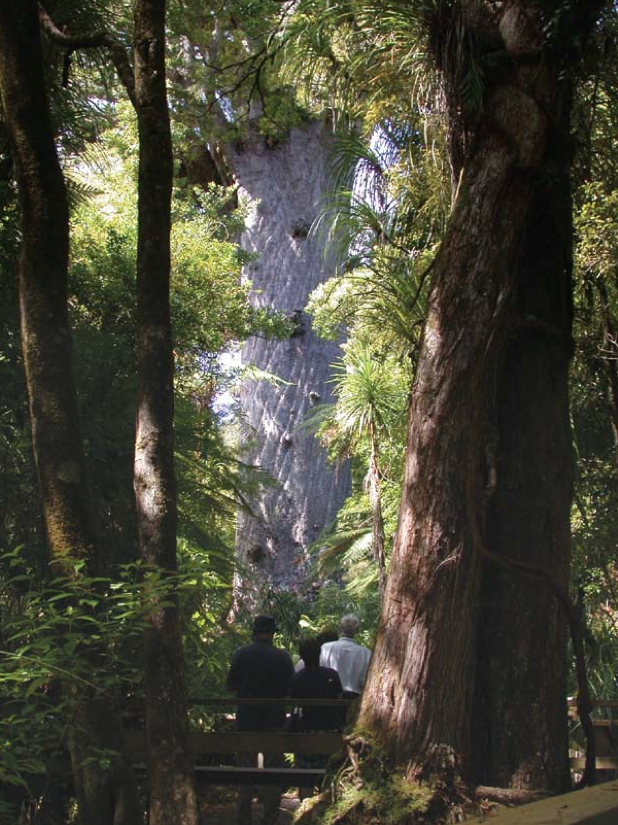“Kindness is the mark we leave on the world.”
Do memories of a place you’ve visited come back to you with a yearning, an ache, that pulls you back? You just may decide you’d love to re-visit that location that tugged at your heartstrings.
Why? At first, landscapes come to mind. You have visions of sweeping vistas, gurgling brooks, snow-capped peaks. But then your mind focuses in and you realize that it is the friendliness of the locals that make you want to return.
During our world circumnavigation, Gunter and I came across powerful places and friendly people who pulled us in and caused us to fall in love.
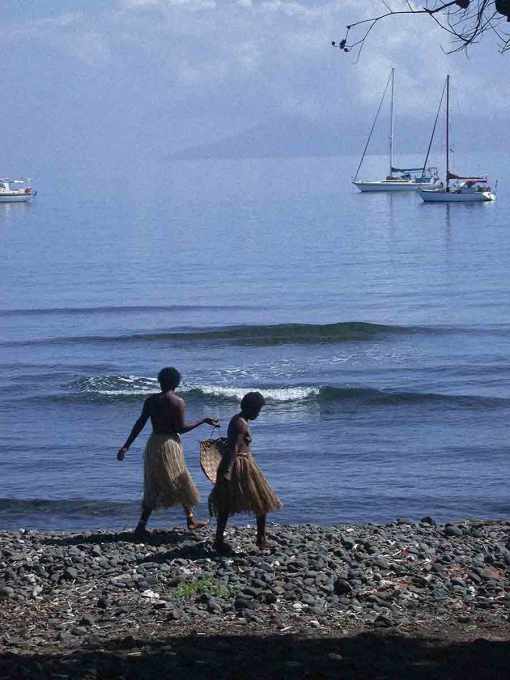
Two local women walk along the shores of Waterfall Bay collecting shellfish. Sailing the South Pacific, page 254.
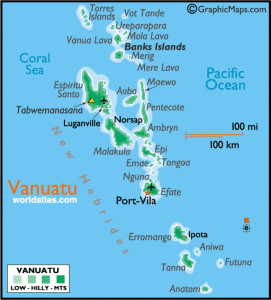 The Propeller Thank You Party in Vanuatu. One place that stole our hearts was Vanuatu (formerly New Hebrides), an archipelago of 80 Melanesian islands. Gunter and I had recently attended week-long festivities honoring the installation of a new chief at Waterfall Bay, in Vanua Lava, one of the Northern Banks islands. We left fond memories those villagers behind and anchored in Vureas Bay on our way back to Luganville. As soon as we were settled, rowers came to welcome us. We recognized the men from the festival and remembered that they had to leave early because of a faulty prop. Gunter had looked at it there and tried to fix it, as had other cruisers.
The Propeller Thank You Party in Vanuatu. One place that stole our hearts was Vanuatu (formerly New Hebrides), an archipelago of 80 Melanesian islands. Gunter and I had recently attended week-long festivities honoring the installation of a new chief at Waterfall Bay, in Vanua Lava, one of the Northern Banks islands. We left fond memories those villagers behind and anchored in Vureas Bay on our way back to Luganville. As soon as we were settled, rowers came to welcome us. We recognized the men from the festival and remembered that they had to leave early because of a faulty prop. Gunter had looked at it there and tried to fix it, as had other cruisers.
“How is the prop?” Gunter asked.
“Still broken. We cannot trust it to go out to fish,” our friend Graham replied.
We’re concerned. A setback like this could be disastrous for the village.
Gunter offered them our dinghy’s spare prop. The villagers were surprised to see that it was shiny, black, and brand new.
“Such a good prop, just for us?”
“We will not need it. Soon we will leave from Luganville, sail past New Caledonia and on to Australia. We will leave our yacht there during the cyclone season,” Gunter explained.
Grateful for the prop, the locals invited us to a thank you party.
From Sailing the South Pacific:
When we arrive, we’re amazed at the setting. A fish line has been strung between two lines and a post. Draped over that line is an abundance of tropical flowers and long plant leaves. Inside this boundary lies a western-style, rooster-print tablecloth covered with many mats and containers, all bursting with food: manioc with nuts, yam laplap-and-coconut, baked papaya, chicken with vegetable greens, and prawns.
“Sit,” an auntie commands us. She is a large, plump woman, wearing a flowered muumuu housedress. We settle onto the grass. About a dozen villagers gather around, but they all remain standing. I motion for them to sit on the grass, too. They shake their heads no.None of the locals—including the children—will take their own food until we begin to eat.
I say grace and then they pass the food to Gunter and me. We receive glass dishes and spoons. “Sorry, we don’t have forks,” our host apologizes. The village nurse, another guest, is offered food next, followed by a couple of men. Our host and hostess and the ladies who prepared the food all stand to the side, smiling. They say they will eat later. After we’ve eaten, the men tell us how much they appreciate the new prop. The nurse makes a speech telling us how much she and the village appreciated the bag of prescription glasses and sunglasses we had given them during the festival.Then she hands us a huge hand-woven basket filled with six eggs, one coconut, two pumpkins, and a huge green cabbage. “For your return voyage. Thank you from all of us.”
I’ll never forget this precious moment!
Tomorrow we’ll face the elements and whatever else is in store for us. But tonight, I glow in the happiness and joy that flows from this wonderful group of islanders.
We talk with them about our goal of sailing around the world. Graham asks, “Why would you want to do this?”
“To see how different people live around the world. And to experience happy moments like this one you are giving to us today.” Gunter says.
They smile and nod in understanding.”
I may never return to the Northern Banks Islands of Vanuatu. These islands are accessible only by boat. But the locals we met there will always hold a special place in my heart.
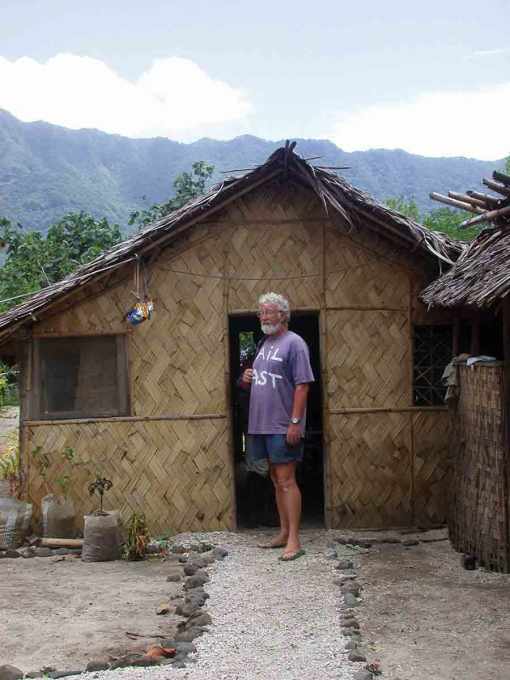
Gunter enters a hut in Vanuatu.
Welcome Week in Bundaberg, Australia. Another one of these powerful places was Bundaberg, a small town on Australia’s northeast coast. We had entered the Port2Port Rally from Vanuatu to Australia. Greg and Pat Whitbourne, Aussies we had met in Vanuatu, shepherded us into their country.
From Sailing the South Pacific:
The next day, when I come on watch at 0300, I can see the lights of Bundaberg glimmering on the horizon, as if the town is expecting us.
Australia, the long-awaited Land of Oz!
I make a pot of coffee. Then I sit at the helm taking it all in. A shooting star streaks across the sky. Surprisingly, a white tern appears from nowhere; it circles the bows and then lands on the pulpit seat for the ride on in. I view both events as a sign of good luck. Ahead—to our starboard—the running lights of Rascal Too bounce through the waves. Our new Aussie friends, Greg and Pat, are magnanimously leading us into their country.
Never before have I felt such a sense of elation and destiny upon arriving at a foreign port!”
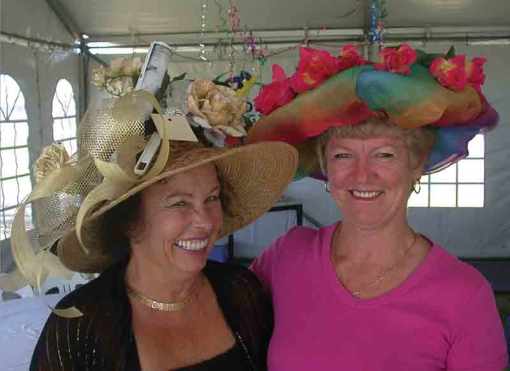
Lois and Pat wearing their hats for the contest.
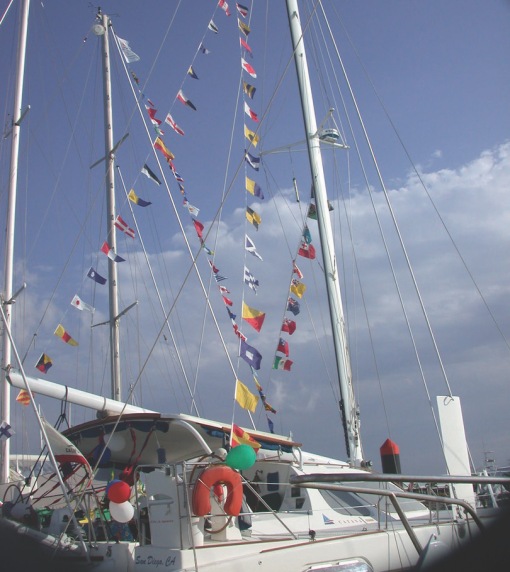
Pacific Bliss won the Best Dressed Yacht contest.
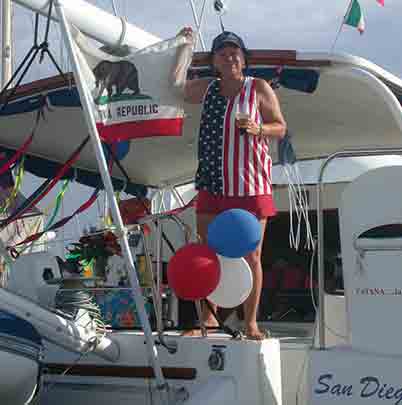
Lois on board Pacific Bliss.
That elation continued as the town put on a Welcome Week celebration for the arriving cruisers.
Pat and I entered the Melbourne Cup Hat Day contest, scrounging for items from our respective yachts. The four of us entered the Brain Strain, Passage Story, and lethal Bundy Rum Drink contests. Finally, Gunter and I entered our catamaran, Pacific Bliss, into the Best Dressed Yacht competition, with the theme: We Love You, Aussies! We won.
Why wouldn’t we want to revisit such a friendly town?
La Dolce Vita at Vibo Marina, Italy. Our sojourn in Italy did not get off to a good start. While approaching the Strait of Messina, Pacific Bliss was caught up in drift nets, due to illegal bluefin tuna fishing—a modern-day La Mattanza. Reggio Calabria, a port of entry, was jammed, with no room for yachts-in-transit. We were relegated to a commercial quay to wait while authorities took their time checking us in. Meanwhile, we found that all nearby Italian marinas were fully booked in July, disregarding the 10% international rule for yachts-in-transit. We felt like the Flying Dutchman, destined to travel the seas forever! Finally, we finagled a berth at Tropea for “one night only.” From there, we hired a taxi to drive us down the coast to search for marinas. The Stella Del Sud Marina, owned by an Italian-Canadian couple, was our best bet. The next afternoon, we arrived amid flashes of lightning and cracks of thunder. We approached the breakwater as two men in a dinghy motored toward us. We knew where we’d be berthed so Gunter inched forward. One of the men yelled, “Stop! We didn’t expect a catamaran. You’re too big!”
I visualized the Flying Dutchman scenario again. We’d be sailing another 40 miles to the next harbor in a thunderstorm. And who knows what we’d find there?
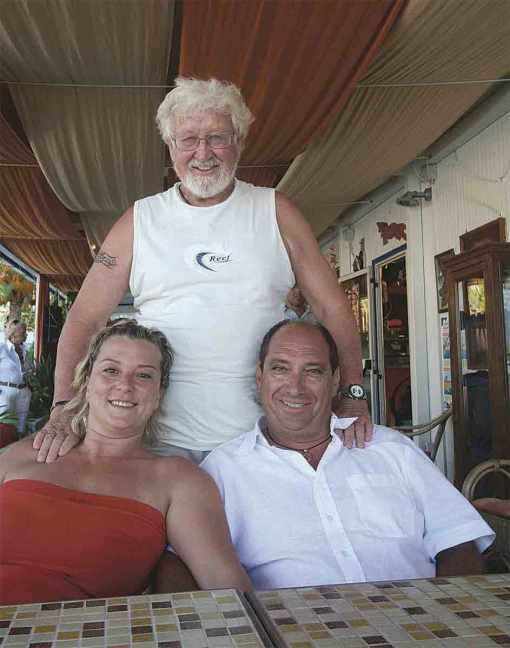
Gunter stands behind Angela and her husband, owners of the Stella del Sud Marina. The Long Way Back, page 410.
Angela, the Canadian, came to our rescue. Soon her husband was standing at the end of the dock, gesturing and directing three dock boys, who pushed and pulled on a mess of mooring lines. Eventually, Pacific Bliss was cleverly tied to the end of the pontoon dock with two mooring lines holding the bow in place and two crisscrossed to hold our stern still. There she stayed, straddling the end of the dock. The passerelle was set up for us to exit from the starboard swim steps. We never saw anything like that, but it worked! We had settled into a sleepy, laid-back Calabrian town. What a relief!
In my third book, The Long Way Back, I wrote about how we fell in love with this place and its people:
We are settling into the sweet life, la dolce vita, in Italy. This little town is growing on us. Vibo Marina is somewhat of a utilitarian place: the buildings aren’t grand—they’re simply old. The streets aren’t paved with ancient cobblestones—they’re simply narrow. The town is stuck in time, situated between two touristy locations: Tropea to the south and Pizzo to the north. And it’s just what we need!
After a week here, we know where to find the best gelaterias (on the beach front road), the best supermarket (Sisas, under the overpass—they even deliver), take-out pizza (a few blocks inland) and high-grade engine oil in four-liter jugs. We’re gaining some familiarity with Italian customs and the language—because we both speak some Spanish, and Italian is similar. But it’s the people who make life here a delight. Angela is becoming a valued friend; her family is gracious and helpful. And the rest of the marina staff treats us wonderfully.”
I hope you’ve fallen in love with some special places as well. I’d love to see your comments.
You may also enjoy: Breaking Bread with the Locals
About the Author: Lois and Günter Hofmann lived their dream by having a 43-foot ocean-going catamaran built for them in the south of France and sailing around the world. Learn more about their travel adventures by reading Lois’s award-winning nautical adventure trilogy. Read more about Lois and her adventures at her website and stay in touch with Lois by liking her Facebook page. Lois’s books can be purchased from PIP Productions on Amazon.
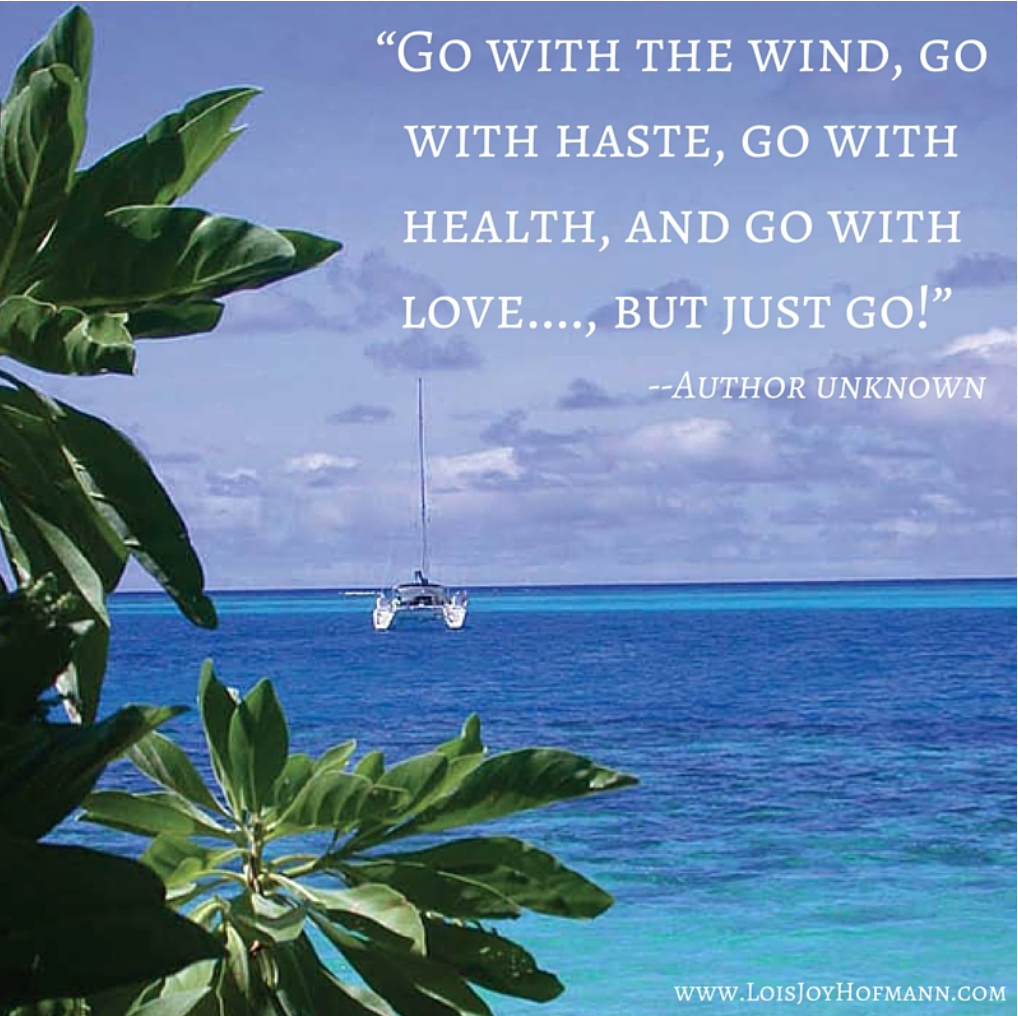
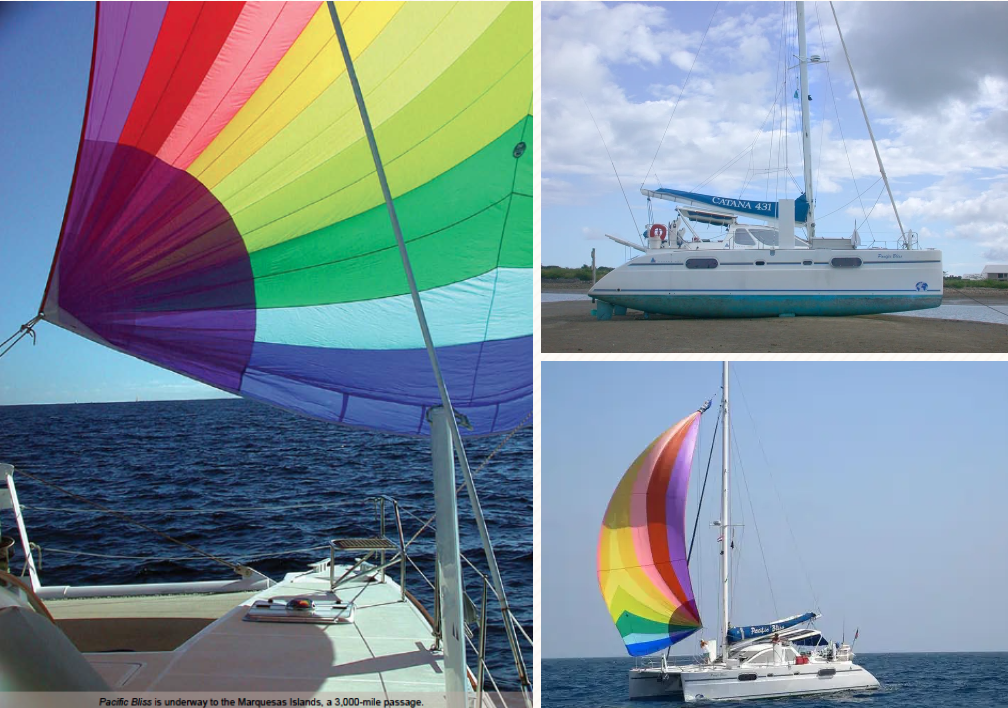

 The Propeller Thank You Party in Vanuatu. One place that stole our hearts was Vanuatu (formerly New Hebrides), an archipelago of 80 Melanesian islands. Gunter and I had recently attended week-long festivities honoring the installation of a new chief at Waterfall Bay, in Vanua Lava, one of the Northern Banks islands. We left fond memories those villagers behind and anchored in Vureas Bay on our way back to Luganville. As soon as we were settled, rowers came to welcome us. We recognized the men from the festival and remembered that they had to leave early because of a faulty prop. Gunter had looked at it there and tried to fix it, as had other cruisers.
The Propeller Thank You Party in Vanuatu. One place that stole our hearts was Vanuatu (formerly New Hebrides), an archipelago of 80 Melanesian islands. Gunter and I had recently attended week-long festivities honoring the installation of a new chief at Waterfall Bay, in Vanua Lava, one of the Northern Banks islands. We left fond memories those villagers behind and anchored in Vureas Bay on our way back to Luganville. As soon as we were settled, rowers came to welcome us. We recognized the men from the festival and remembered that they had to leave early because of a faulty prop. Gunter had looked at it there and tried to fix it, as had other cruisers.














